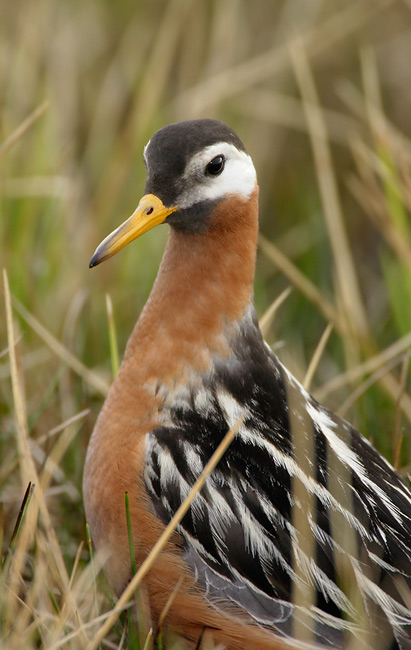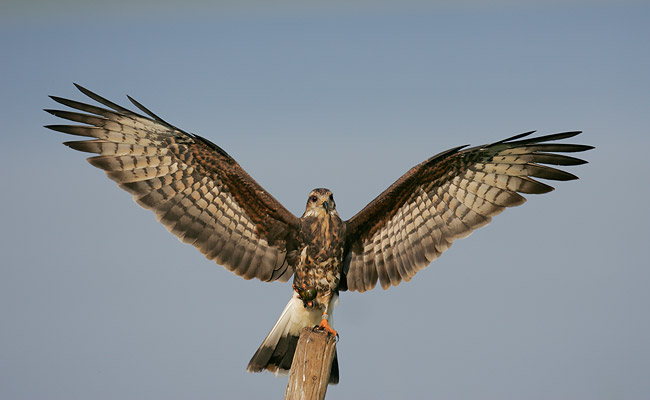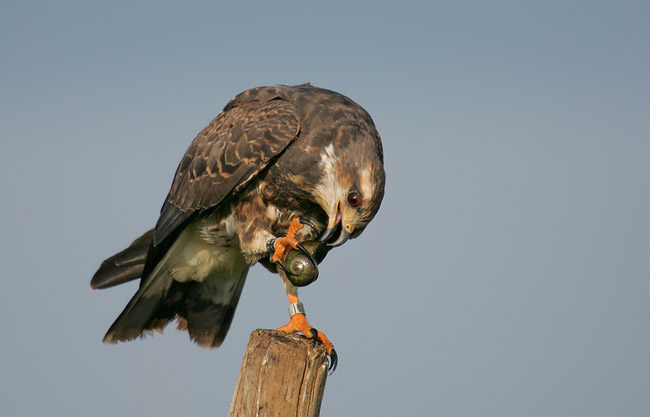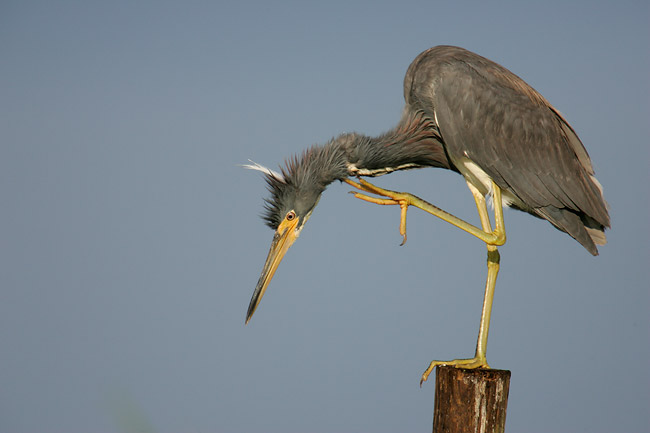Photo Theme: Odds and Ends from the past month...
Red Phalarope, Barrow, AK
Image copyright 2004 Arthur Morris/BIRDS AS ART
Canon EOS 1D Mark II digital camera with 500mm f/4 L IS lens & 2X II TC.
ISO 250. Evaluative Metering at 0: 1/250 sec. at f/8 in Av Mode.
Fill flash at -1 2/3 stop with Better Beamer FX-2
This was one of the target birds for my Barrow trip and I had many good chances with this species. The phalaropes have reversed sexual roles with the brightly colored females pursuing and guarding their drab mates. The males have sole responsibility for incubating the clutch (while the females are busy looking for other sex partners)... Here I used One-Shot AF, locked focus on the bird's eye, and recomposed.
PRICE SLASHED ON DELKIN 640 e-FILM PRO-CARDS!
Just today, we were able to reduce the price of the cards that I use every day by $35!
DELKIN 640 e-FILM PRO CARDS
$164.98 per card plus $7.50 shipping per order.
The flash cards will be sent by US Priority Mail/Certified/Return Receipt Requested so you will need to sign for your order.
One card:$172.48 ppd. Two cards: $337.46 ppd.
Three cards:$502.44 ppd. Four cards: $667.42 ppd.
(Florida residents will need to add 6% sales tax to the cost of the cards only: $174.88 per card plus the $7.50 per order shipping.)
Please make all checks out to "Arthur Morris" and send to Arthur Morris/BIRDS AS ART, PO Box 7245, Indian Lake Estates, FL 33855
Email for additional overseas shipping charges.
We do not accept credit cards over the phone. If you wish to pay by credit card, please visit the web site and click on the Paypal link. Thanks!
Snail Kite, female, Lake Marian, FL
Image copyright 2004 Arthur Morris/BIRDS AS ART
Canon EOS 1D Mark II digital camera with 600mm f/4 L IS lens.
ISO 250. Evaluative Metering +1/3 stop off of water set manually: 1/1600 sec. at f/5.6
I met Jim Neiger on NatureScapes.net and we struck up an instant friendship, sharing all kinds of bird photography information. Jim works very hard and has made many amazing images with "only" a 10D and the 100-400mm IS L zoom lens. He discovered this exceedingly cooperative bird a few weeks ago and invited me last week to his favorite summer hot-spot (with the emphasis on hot)! Notice that even though I was using the prime lens alone to make this image, I stopped down to f/5.6 for a bit of extra D-O-F. AFPS worked perfectly here tracking the bird accurately as it flew to its perch with a snail.
HIGH SPEED SYNCH WITH THE 550 FLASH
Some good questions from Victor Steel:
VS: I'm curious about your use of Program Mode. I think I understand why you use it with fill flash -- if you were shooting Av mode, the camera may try to set the shutter above the sync-speed, causing the image to be overexposed.
Sort of... If you are working in Av and it is too bright, the Shutter Speed will flash indicating that you need to choose a smaller aperture to prevent overexposure. In the heat of the action, it is easy to overlook the flashing shutter speed. I lost a killer Warbling Vireo image at Pelee one year in that situation when the sun peaked out from behind a cloud... It is unfortunate that the protection offered by enabling the custom function for "Safety Shift" does not work when the flash is on.
Why not use the high-speed sync option on the flash.
I do that at times, but not when I wish to ensure some extra Depth-of-Field. As long as light levels are relatively high, working in Program Mode will (obviously) yield smaller apertures (than when working with HS Synch at the widest aperture).
When do you use High-Speed Synch?
I use High-Speed Synch when using flash for flight photography, and when I wish to ensure that I will be shooting at the wide open aperture (even in relatively bright conditions). Another way to ensure a wide aperture when using flash it to lower the ISO on the fly....
Are there tradeoffs to using high-speed sync?
Yes, very much so. With High-Speed Synch, the flash fires in pulses. At 1/500th sec. I believe that the flash needs to fire twice, at 1/1000 sec. four times, and so on and so forth... With the flash forced to turn on and off almost instantly, the range of the flash is greatly reduced (especially at the higher shutter speeds). When using High-Speed Synch flash I just hope to get a touch of flash on the bird. When doing so the green flash confirmation lamp will usually light up only when you are photographing a subject at extremely close range.
Snail Kite, female biting snail, Lake Marian, FL
Image copyright 2004 Arthur Morris/BIRDS AS ART
Canon EOS 1D Mark II digital camera with 600mm f/4 L IS lens & 2X II TC.
ISO 250. Evaluative Metering +1/3 stop set manually: 1/800 sec. at f/8.
Being able to make razor sharp images at an effective focal length of 1500mm (30X magnification) is a huge plus for bird photographers. Making images that reveal the intimate details of a bird's life while minimizing disturbance is an added plus when working with image stabilized super-telephoto lenses.
NATURESCAPES.NET
is the premier educational nature photography site on the web, and their Avian Gallery is tops in my book. You must register to visit and join to be able to post images on the site.
Tricolored Heron, scratching, Lake Marian, FL
Image copyright 2004 Arthur Morris/BIRDS AS ART
Canon EOS 1D Mark II digital camera with 600mm f/4 L IS lens & 2X II TC.
ISO 250. Evaluative Metering at 0 set manually: 1/800 sec. at f/8.
Aside from the Snail Kite, there are lots of other opportunities at Lake Marian (Red's Fish Camp). Tricolored Heron, Green Heron, Osprey, Boat-tailed Grackle, Prairie Warbler, Bald Eagle, and Osprey are among the species that keep things interesting while waiting for the kite to return. Variety is the spice of life, no?
WHICH LENS IS BEST FOR YOU: the 500mm F/4 OR 600mm F/4 L?
As I am asked about these two lenses several times a week, I wanted to set the record straight once and for all. If you are a Canon user who is strong, rich, and loves to photograph birds exclusively, especially small ones, then, and only then would the 600mm f/4 L IS lens be the way to to go. For Nikon users, the decision is not so clear cut: Nikon does not offer VR (Vibration Reduction) in any super-telephoto lenses, so most folks using Nikon are not comfortable using the big lenses with the 2X teleconverters... The 600 Nikon lens is thus more attractive to Nikon-using bird photographers, and the most expensive (magnesium) edition of this lens is well lighter than the Canon equivalent. With good technique, Canon folks should be routinely able to create consistently sharp images with the 500mm f.4 L IS lens and the 2X TC at shutter speeds as slow as 1/60th sec.
I am fortunate to own two 500mm f/4 L IS lenses and one 600mm f/4L IS lens. (We offer super-telephoto lenses for rent only on IPTs.) I usually use the 600mm lens only when I am working close to my vehicle, or when extremely long focal lengths are required. On some IPTs, however, I wind up renting both 500s and am forced to lug the 600... If I could only own one super-telephoto lens, today--weeks after my 58th birthday (Yikes!)--it would be the 500mm f/4 L IS. For more than a decade I made a living with a maximum effective focal length of 840mm (17x magnification), with the 600mm lens and a 1.4X TC. With the 500mm, a Mark II, and the 2X II TC, I am at 1300mm (26X magnification). The image of the bird with the latter setup is 2.395 times larger in the frame than it would be if one were working at 840mm. The 500mm is lighter, focuses closer, handles much more easily on the ground and in the car, is easier to travel with, and costs less... For me, case closed!
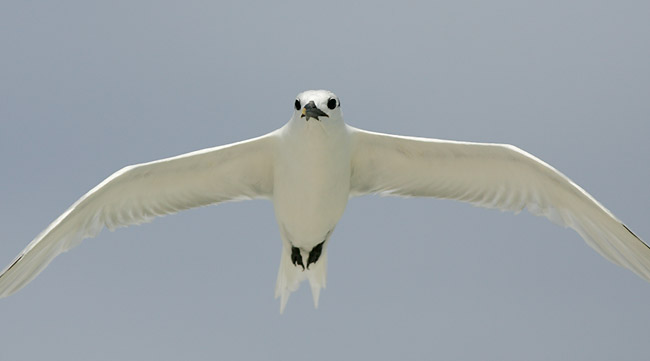
Sandwich Tern-adult Egmont Key NWR, FL
Image copyright 2004 Arthur Morris/BIRDS AS ART
Canon EOS 1D Mark II digital camera with 400mm f/5.6 L lens (handheld)
ISO 250. Evaluative Metering at 0: 1/3200 sec. at f/7.1 in Av Mode.
When I visited Egmont Key I decided to use the central sensor only for flight and to try Custom Function 17-1. Virtually every single image was tack-sharp on the eye... On my June visit, there were hundreds of nesting pairs of this species, so I was surprised that there were very few Sandwich Terns around and almost no young-of-the-year of this species (when I returned last week).
2005 ST. AUGUSTINE ALLIGATOR FARM IPT ANNOUNCED!
St. Augustine Alligator Farm IPT April 28-May 1, 2005. 3 1/2-DAYS: $1049
Late April/early May at this amazing rookery is prime time for both Great and Cattle Egrets at the absolute height of breeding plumage, and barring natural disaster (like the big storms in April 2003), there should be lots of newborn Great Egret chicks in nests at eye-level and close range. There will be lots of Snowy Egrets and Tricolored Herons in good color as well, and all of the birds will be courting, copulating, and building nests, and there will lot of excellent flight photography as well. Join us to learn how to make a variety of great images in a rookery situation.
There will be several logistical changes on this IPT. For starters, it will be the first ever 3 1/2- Day IPT; there will be four afternoon sessions (rather than the usual three). Slide programs will be held on three afternoons at the Alligator Farm's beautiful Education Building. This will allow us to photograph more during the cooler hours. We will quit early, have lunch, take a break, and get the slide program out of the way before the late afternoon photo session. This will allow us to take advantage of the very best light and the heightened activity just before sunset.
The introductory slide program will held be on the first afternoon of the IPT, Thursday April 28 at 2:00pm. There will be an afternoon photography session that afternoon, and additional programs on Friday and Saturday afternoons. The will be morning and afternoon photography sessions Friday thru Sunday, three mornings and four afternoons in all. For cancellation polices and additional info, visit: http://www.birdsasart.com/tours.html
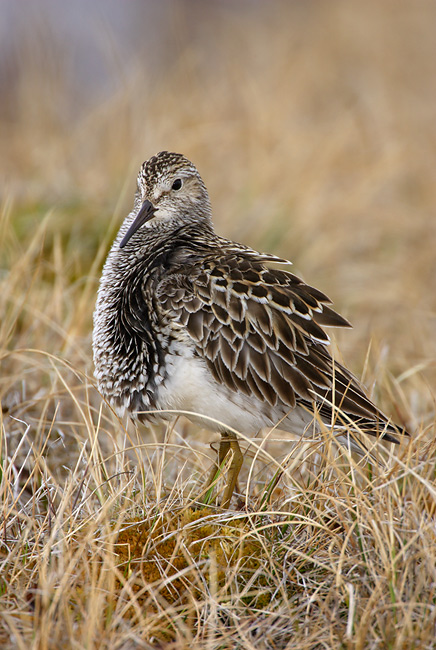
Pectoral Sandpiper-male, Barrow, AK
Image copyright 2004 Arthur Morris/BIRDS AS ART
Canon EOS 1D Mark II digital camera with 500mm f/4 L IS lens & 2X II TC.
ISO 250. Evaluative Metering +1/3 stop: 1/400 sec. at f/8 in Av Mode.
Fill flash at -1 2/3 stop with Better Beamer FX-2
Seeing male pecs flying about the tundra hooting surreally with their breast sacs distended was a thrill. The thing that I like most about this image is the regal look and the fact that the bill is centered on the upper breast...
IPT QUICKIE UPDATES
The Bosque Del Apache NWR, NM 2004 IPTs NOV 21-23 IPT (Sold Out) NOV 27-29 IPT (Sold Out) Please e-mail if you would like your name placed on the waiting lists.
The SW Florida IPTs Post X-mas: DEC 28-30, 2004 3-DAY: $869 (5 Openings) PRESIDENT'S HOLIDAY: FEB 18-22, 2005, 5-DAY: $1399 w/Ellen Anon co-leading) (6 Openings)
The San Diego IPT San Diego IPT: January 6-9, 2005, 4-DAY: $1299 (3 Openings.)
Homer, AK, Bald Eagle IPT w/co-leader Greg Downing FEB 4-8 & 9-13, 2005 5-DAY: $1599. 10-DAY: $2999 (both are near sell-outs)
Lake Martin, La, Nesting Spoonbill IPT 3 -DAY: $899 MAR 19-21 (3 Openings)
MAY 13-15, 2005 (5 Openings)
Fort DeSoto/Sarasota IPT: April 8-10, 2005 (Please note likely date change to April 1-3) 3-DAY: $869 (7 Openings)
Register now! You snooze, you lose!

White-fronted Goose on eggs, Barrow, AK
Image copyright 2004 Arthur Morris/BIRDS AS ART
Canon EOS 1D Mark II digital camera with 500mm f/4 L IS lens & 2X II TC.
ISO 250. Evaluative Metering +1/3 stop: 1/250 sec. at f/11 in Program Mode.
Fill flash at -1 1/3 stop with Better Beamer FX-2
This bird was nesting just off the road under the gas pipeline. By the next morning, it had been shot-gunned by brave native subsistence hunters working from their ATV... I learned later that the season had closed a week or two before...
Best and love and great picture making to all,
Artie
